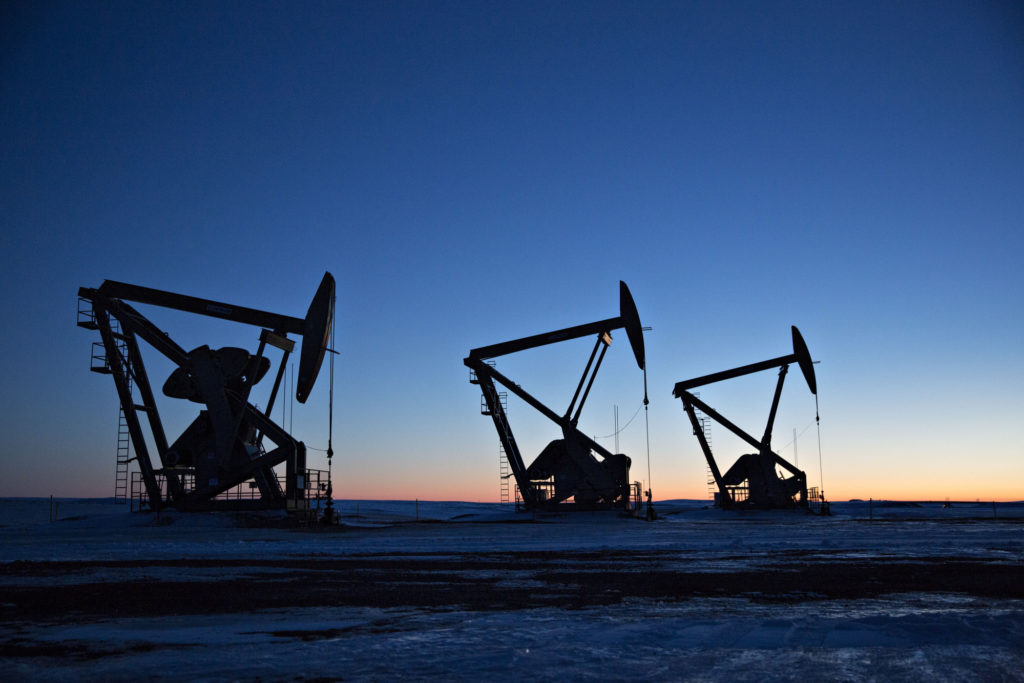
Oil rose from its lowest settlement in more than a year in New York, though signs of record output from Saudi Arabia amid pressure from President Donald Trump continued to weigh on the market.
Futures added 1.7 percent, after slumping 7.7 percent on Friday. Saudi Arabia is pumping as much as 11.2 million barrels of crude a day, the most since the kingdom extracted its first oil eight decades ago, according to a person familiar with the matter. Trump has reiterated his view that falling oil prices are great after the U.S. benchmark plunged the most last week since January 2016.
The American crude marker teeters near the $50 threshold as the Saudi output surge combines with larger-than-expected exports of Iranian oil after Trump granted sanctions waivers to some nations. In the U.S., growing inventories have added to the pressure on prices. Traders are assessing whether the Organization of Petroleum Exporting Countries and its allies will decide to trim output when they meet early next month in Vienna.
The recent weakness in oil seems “to have been driven by a wider sense of impending doom amid weak equities, geopolitics, subsequent softening demand and increasing supply,” said Jack Allardyce, oil and gas analyst at Cantor Fitzgerald LP.
West Texas Intermediate for January rose 84 cents to $51.26 a barrel on the New York Mercantile Exchange at 8:53 a.m. local time. The contract plummeted 10.7 percent last week. There was no settlement on Thursday due to the U.S. Thanksgiving holiday. Total volume traded Monday was about 29 percent above the 100-day average.
Brent for January settlement climbed $1.37 to $60.17 a barrel on London’s ICE Futures Europe exchange, after slumping below $60 on Friday for the first time since October 2017. The global benchmark traded at an $8.84 premium to WTI. The global benchmark’s nearest timespread briefly surged into a bullish backwardation — indicating tight supply — after an outage at a North Sea oil field.
Trump, who’s made his opposition to OPEC a regular theme, has continued to comment on Twitter about the benefits of cheaper crude. He thanked Saudi Arabia last week for lower oil prices. He has also been critical of the Fed, describing the central bank as a “ problem” as he called for lower interest rates.
Saudi Arabia’s higher output is playing its part in reducing prices in response to the pressure from Trump. Yet Energy Minister Khalid Al-Falih said last week that demand for Saudi crude may be lower in January than in December and his country will only produce as much oil as its customers need.
OPEC and its partners are set to meet on Dec. 6 and 7 in Vienna, but the direction of next year’s oil prices may well be decided later this week when the key decision makers are set to gather on the sidelines of the G20 summit in Buenos Aires. Saudi Crown Prince Mohammed Bin Salman and Russian President Vladimir Putin are both scheduled to be in the Argentinian capital, along with their energy ministers.
Other oil-market news: Hedge funds haven’t been this pessimistic about global oil prices since Brent crude was spiraling into its worst rout in a generation almost three years ago. Equity markets gained with European stocks and U.S. futures trading higher Ukraine’s parliament will vote on whether to impose martial law after Russia fired on its warships Sunday. Brokerage PVM Oil Associates Ltd. cited the political tensions as another supporting factor for crude prices Monday Oil is unlikely to return to above $100 a barrel, and current prices are making it difficult for major producers such as Angola, according to the country’s president.
Recommended for you
